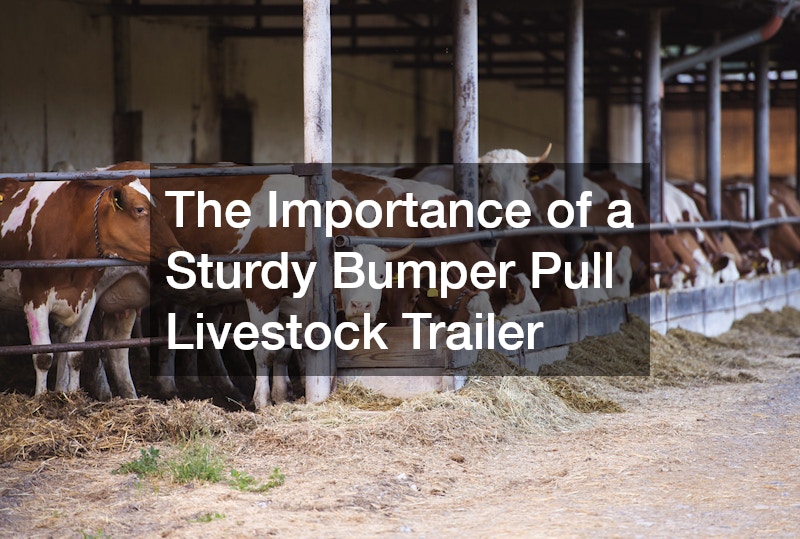

A reliable bumper pull livestock trailer plays an essential role in ensuring the safety and comfort of your animals during transit. Investing in a sturdy model not only provides peace of mind but also protects your valuable livestock from stress and injury.
Why Choose a Bumper Pull Livestock Trailer?
Benefits Over Other Trailer Types
Bumper pull trailers are often preferred for their ease of use and compatibility with a variety of towing vehicles. Unlike gooseneck trailers, bumper pull models can be hitched to almost any pickup truck or SUV, making them versatile and convenient.
Their lower hitch point allows for simpler hook-ups and unhooking, which can be beneficial for operators who frequently travel alone. Additionally, they tend to be more affordable than gooseneck trailers, making them an attractive option for those on a budget.
This type of trailer is also generally lighter and smaller, making it easier to maneuver in tight spaces. For livestock owners traveling through rural areas or less accessible locations, this maneuverability is a significant advantage.
Suitability for Different Livestock Types
Bumper pull livestock trailers are designed to accommodate a wide range of animals, from cattle to horses, showcasing their versatility. The versatility of these trailers means that livestock owners don’t need multiple trailers for different types of animals.
The interior design often includes flexible partitioning options that allow for adjustments based on the livestock being transported. This adaptability ensures that animals have the appropriate space and conditions, critical for minimizing stress during travel.
Furthermore, the compact size and stable design of bumper pull trailers make them ideal for transporting smaller animals or mixed loads. Owners can rest assured that their animals are secured safely, regardless of the terrain or distance traveled.
What Makes a Bumper Pull Trailer Sturdy?
Material and Construction Quality
The use of high-quality materials, such as galvanized steel or aluminum, is crucial for enhancing the strength and longevity of a bumper pull trailer. These materials are resistant to rust, providing durability in various weather conditions.
Expert construction, including precise welding and fitting, further ensures the trailer’s resilience and performance over time. Attention to construction quality helps prevent issues such as vibration and premature wear and tear.
Investing in a well-built trailer often translates into reduced maintenance needs, saving time and resources in the long run. Quality construction ensures reliability, which is indispensable for safe livestock transportation.
Structural Integrity and Design Features
Structural integrity is a hallmark of a sturdy bumper pull trailer, supported by features like reinforced flooring and robust frames. Reinforced flooring prevents sagging under heavy loads, ensuring a stable transport environment.
Key design features such as ventilation systems and secure latch mechanisms further enhance the trailer’s performance. Good ventilation reduces the risk of heat stress, while secure latches prevent accidental openings during transit.
Moreover, trailers with strategically positioned safety features protect both the livestock and handlers during loading and unloading. These design considerations are essential for a trailer’s overall sturdiness and usability.
How to Ensure Safety with Your Livestock Trailer
Regular Maintenance and Inspection
Conducting regular maintenance and inspections is vital to ensuring the safety of a livestock trailer. Routine checks should include examining tires, brakes, and the hitch for wear and tear.
Keeping tabs on these components reduces the risk of mechanical failures that could endanger the animals during transit. Preventative maintenance, such as lubricating moving parts, also extends the lifespan of the equipment.
Moreover, a thorough inspection should involve looking for structural damage that might compromise the trailer’s strength. Addressing such issues promptly helps maintain the reliability of the transport vehicle.
Loading and Unloading Best Practices
Loading and unloading livestock safely requires careful planning and execution to prevent injury and stress. Establishing a calm environment can help reduce animal anxiety, making loading smoother.
Using proper techniques and equipment, such as ramps with non-slip surfaces, is crucial for safe transitions. Handlers should guide livestock swiftly yet calmly, minimizing waiting time inside the trailer.
Clear and consistent communication among handlers is also essential for a successful operation. Working together ensures that animals are loaded and unloaded efficiently and humanely.
What Are the Cost Considerations?
Initial Purchase Cost
The initial cost of a bumper pull livestock trailer can vary widely based on factors such as materials, size, and included features. Generally, entry-level models are more budget-friendly, while high-end options with advanced features demand a premium.
It’s essential to balance upfront cost with durability, making sure that the trailer will meet your needs long-term. Spending more on a higher-quality model may result in cost savings due to fewer repairs and issues down the road.
Long-Term Value and Investment
A sturdy bumper pull livestock trailer is often a valuable long-term investment due to its potential for a lengthy service life. Durability and reliability translate into fewer issues, reducing costs over time and increasing value.
Choosing the right model can impact your operations positively, enhancing efficiency and ensuring animal welfare. A well-maintained trailer may have a higher resale value when it’s time to upgrade or sell.
How to Choose the Right Bumper Pull Livestock Trailer?
Assessing Your Needs and Requirements
Selecting the right trailer begins with a thorough assessment of your specific needs and requirements. Consider the types and number of livestock you will be transporting regularly to determine the optimal trailer size.
Other factors such as distance traveled, frequency of use, and towing vehicle compatibility also play a crucial role in the decision-making process. A well-suited trailer enhances your operational efficiency and ensures the comfort of your livestock.
Comparing Brands and Models
When comparing brands and models, consider the manufacturer’s reputation, customer reviews, and warranty offerings. Reliable brands often provide more robust customer support and higher-quality construction.
Make sure to evaluate the specific features each model offers, ensuring they align with your priorities and operational requirements. Features such as ease of cleaning, customization options, and safety elements are crucial.
.



